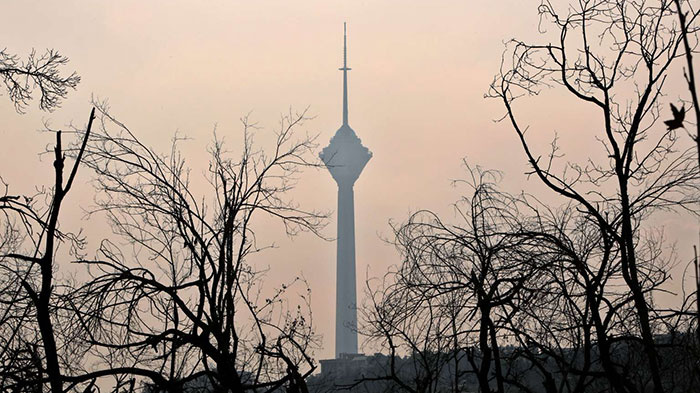How Aggravating Air Pollution Is Exposing Tehran Citizens to a New Disease

On Saturday, Shahrvand Daily, the official organ of Iranian Red Crescent Society, reported that only in two Tehran hospitals, almost 90 patients are annually diagnosed with Anthracosis, a respiratory condition commonly known as black lung disease.
“We have caught the coal worker’s disease in Tehran -- a city with no coal mines. Blackness has been building up in our lungs, our every breaths, every hallo that we say,” read the lede of Shideh Lalami’s Shahrvand cover story.
One of the two hospitals with reported diagnosis of the disease is Masih Daneshvari Hospital, specialized in respiratory diseases ironically located on the uptown Darabad Street, in a neighborhood known for its cool fresh air on the skirts of one of the most polluted cities in the Middle East.
“At least, sixty patients are diagnosed with Anthracosis only in this hospital each year. We have recently found that thirty other cases are reported in Imam Khomeini Hospital each year,” said Dr. Mohammad Seyyed Mahdi, director of Masih Daneshvari Hospital’s department for air pollution and occupational diseases. “It is a remarkable figure,” he adds in an interview with Shahrvand, noting that there may be sufferers reported elsewhere or still undiagnosed.
Anthracosis is a milder form of Coal workers’ pneumoconiosis (CWP), also known as ‘black lung’, which is often asymptomatic, making its diagnosis difficult. The main cause of the ailment is exposure to coal dust, found in emissions of combustive equipment and diesel vehicles as a result of incomplete combustion.
As Vahid Hosseini, the director of Tehran Air Quality Control Company told Shahrvand, human body has no defense mechanism against coal dust or carbon. Hosseini said carbon contaminants could affect genetics, and its impact in cell division and cancer has been proved.
Carbon or soot is categorized under suspended particulate matters (SPM), smaller than 2.5 micrometres, which can infiltrate cellular textures in human lungs.
Shahrvand quotes a Swiss pulmonologist, Dr. Schlicht, who has recently addressed the “Tehran, Soot-Free City” specialized summit, saying that studies show victims of SPM in a 100-million urban population could be as many as 40,000 deaths from cardiovascular, respiratory and brain diseases and 200,000 cases of cancer.
“There is no healthy standard for carbon because our bodies are too vulnerable against soot,” Hosseini told Shahrvand. While many countries have eliminated carbon in the air using diesel particulate filters, Hosseini said black carbon accounts for 10 to 15 percent of the suspended particulate matter in Tehran’s air. Hosseini predicated a final judgment about possible adverse effects on the healthcare ministry’s ruling. “However, we should ask ourselves where the carbon built up in citizens’ respiratory system comes from,” he added.
Dr. Seyyed Mahdi also said further research is needed to speak about the prevalence of black lung with certainty. What seem certain is that an increasing number of patients are coming in. All it takes is credit and cooperation between health and research institutions. Shahrvand highlights the lack of an integrated database on pollution-related diseases, which leads to inaccurate statistics on the number of deaths caused by air pollution. In spite of a rising awareness about risks of cancer in air pollution, respiratory and cardiovascular illnesses that usually occur in middle age are not included in statistics.
Air pollution death toll figures recorded in Iran only include immediate deaths, not the long-term cases, Tehran Air Quality Control’s Hosseini told Shahrvand. “Cancer and lung diseases victims are not included and that is why we believe that total death numbers of 26,000 in Iran and 5,000 in Tehran each year is just the minimum,” he added.
According to Hosseini, investigations indicate a shift in the profile of air pollutants in Iran. Some have gone with lifestyle alterations while new ones including BTEX and NO2 are on the rise. The density of suspended particulate matter concentration is reported on a daily basis in Iran’s big cities including Tehran but there have been no comprehensive programs to monitor and investigate the components.
Apart from the short-term solution of soot filters, Shideh Lalami’s article also calls for stricter policies to curb production and ban the commute of vehicles that do not meet environmental standards as well as nationwide access to ultra-low-sulfur diesel (ULSD).
Iran has vowed to renew its transportation fleet, a plan that has met bureaucratic and credit complications over the past decade. According to Shahrvand, although Iran has imported soot filters, lack of infrastructure, including standardized fuel is still a problem. Giant Iranian automakers are also reluctant to equip their cars with necessary filters due to heavy costs. Even prestigious international brands including Benz have allegedly started exporting non-standard diesel cars which cannot be sold in European markets.
Air pollution, deteriorated by thermal inversion, has shut down schools for a few days this very quarter. For almost two decades, authorities have done little but to impose traffic limitations while calling school and sometimes universities off. Over the past months, Tehran has seen two citywide traffic gridlocks, during which public transportation also proved incapable.

